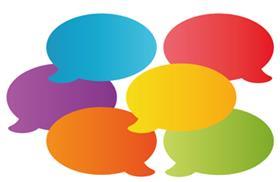Prepare for your influx of new students with twenty activities to kick off the new term.

The first time a new class meets is often a nervous moment for the teacher and students alike. It always helps to have a few tried and tested first class activities up your sleeve to break the ice and get started on the right foot. Here are twenty activities to get your new classes off to a good start.
- Learn your students’ names. This is perhaps your most important task during a first class. Try writing their names on the board in the order in which they are seated and use them as much as possible in that first lesson. If the names are difficult to remember, ask them to tell you where the stress is (a good way of introducing the notion of word stress) and whether it means anything, whether it is a family name, a regional name, a diminutive, etc.
- Make sure your students know each other’s names. One technique is to do a round of the class, where each student takes a turn to say, “My name’s _____ and I’m interested in ____.” while recapping the other students who have already introduced themselves, such as, “Her name’s _____, and she’s interested in _____.” You can repeat this every time a latecomer arrives.
- Give learners a chance to prepare some questions to ask you about yourself. They can do this in pairs (by now they should know each other well enough), taking it in turns to read out their questions for you to answer. Don’t feel obliged to answer them all. Saying, “I’ll pass on that one.” is a useful way of establishing that the students, too, don’t have to answer every question that’s put to them. They can then ask the same questions to each other, working in small groups.
-
Show beginner-level students how much they already know by putting them into groups and telling them to make a list of all the English words they are familiar with. Then, get the groups to write the words on the board. The idea is that the board will be covered by a mass of words. This should boost the students’ confidence.

- Cut several lengths of string (half the number of students that are in the class). Clasp the lengths of string in the middle so the ends are hanging on both sides. Next, tell the students to take a good look at each other. Then, tell them to come to where you are standing and each take hold of one end of string. Let go of the string so that the students can discover who their mystery partner is, i.e. who is holding the other end of their string. The students then take it in turns to stand back to back with their string partner and describe their partner to each other – what they look like, what they’re wearing, etc.
- Find out how much vocabulary students can remember after their holidays. Students take it in turns to say a word, but the first letter of their word must be the same as the last letter of the preceding word. For example: school, life, exam, madness, etc.
- Help the students find their way around the school and discover what facilities are on offer. You could write some true / false questions which the students can answer only by exploring the building, e.g. The library is opposite Room 21.
- Spend the break with the students. You don’t have to do this all the time, but chatting with them informally will give you a sense not only of their language level but of their personalities.
- Younger students might enjoy a treasure hunt around the school building. Write a sentence of about seven words with each word on a separate piece of paper. Leave the pieces of paper pinned to the walls in different parts of the school. On each piece of paper, you should write instructions explaining where to find the next piece. For example: Go upstairs, turn right and look beside the fourth door on the left. The students follow the instructions, making a note of the seven words that they find. They should then put the words into the correct order. Give a prize to the student or group that finishes the activity first, then provide feedback on what the students discovered about the school.
- Write a short story which has the same number of sentences as there are students in the class. Give one sentence to each student but not in the correct order. Each student then reads out their sentence in turn. By listening and understanding, the students have to put the sentences into the correct order and sit beside the student who has the preceding sentence. When they have done this, they should read out the complete story. Here’s an example of the kind of story that works well:
Yesterday, a man was walking in the park when he saw a gorilla. He asked a policeman what he should do.
The policeman said, “You should take the gorilla to the zoo.”
The next day the policeman was in the park when he saw the man again. He was still with the gorilla.
I thought I told you to take the gorilla to the zoo,” he said.
“I did,” said the man, “and he enjoyed it so much that today we’re going to the cinema.”
Students can, of course, write their own stories word by word. Each student takes it in turn to say a word, making sure that the words build into sentences to make a story. When a student feels that the end of a sentence has been reached, they can say “full stop”. The next student then starts the next sentence. - Write a paragraph on the board and tell the class that they have to reduce the text to one word. They can take out one, two or three words, as long as they are consecutive. The text must still make grammatical sense when the words have been deleted, even if the meaning changes. Although this may sound like an impossible task, it is nearly always possible. At the next class, you could start with the one word that remained at the end of the previous class and try to reconstruct the whole paragraph. The students will have already worked so hard on the paragraph that this should be relatively easy.
- Write words on the board and get the students to put them into columns headed noun, verb, adjective, preposition, etc. Alternatively, give them a short article from a newspaper and give them tasks such as find a countable noun, find a past participle, find a phrasal verb, etc.
- Write a list of words and numbers on the board that are relevant to you, for example, Edinburgh; 45; country and western; etc. The students then have to discover what the information means by asking you questions. You must answer truthfully. Don’t be too obvious with your choice of words. The questions: Where were you born?, How old are you? and What kind of music do you like? might not be the correct questions for the answers above.
- Take objects to the class that give away some information about you and your character, e.g. your passport, car keys, a book you are reading, your favourite song. The students should then give as much information as they can about you. They can then make sentences about themselves related to the objects, e.g. “I can’t drive.” or “I prefer reading magazines.” This activity also works with holiday objects to elicit information about your or your students’ holidays.
- Write four sentences about yourself and your past on the board. Two of the sentences should be true and the other two invented. For example, you might write:
I am married.
I used to be a rock singer.
I have written four novels.
I was once stopped by the police for carrying an elephant. - The more obscure the sentences are, the better the activity. Now, tell the students what you have done and explain that they must decide which sentences are true and which are false. They should do this by asking you detailed questions and trying to catch you out. The students can then do the same in small groups.
-
Ask the students to draw a five-pointed star on a piece of paper. Then, get them to stand up and form a line from the biggest star to the smallest. They should then pair up with the person next to them. Tell the students to write a name that is significant to them personally on the topmost point of the star, on the next point they should write a number, on the next a date, on the fourth a place name, and on the last a logo or symbol that has personal meaning. They should then talk about their stars with their partner.

- What do your students think about what goes on in a classroom? Elicit different classroom activities and write them on the board, e.g. speaking, reading, writing … Start a pyramid discussion. Individually, students put the activities into a personal order of importance. They compare their list with a neighbour, discuss the two lists and produce a new one. The pairs then form groups, and so on, until you can produce a final class list on the board. Challenge the class to defend their choices. This activity can also work with different subjects, e.g. the qualities a good teacher (or student) needs.
- Put students into groups of four or five and tell them to stand up and push aside chairs and tables as far as possible to create a bit of space. Ask them to introduce themselves to each other and tell them that that they are going to work as a group to make shapes of letters with their bodies, using arms and legs, and standing, sitting, bending over, etc. Give them more letters to create, gradually increasing the pace as they get used to it. You can spell words or names, and use capital and lower-case letters to vary the shapes. At the end, ask them to tell you what word they were spelling.
- Designing a class mascot is a particularly good idea for kids’ classes, but can be useful for adult classes as well. Having a class mascot will make life more fun whenever you need to give examples and don’t want to resort to drawing stick figures on the board. Use the activity to revise parts of the body, instructing the students what to draw. Ask each student to draw a mascot and, when they have finished and presented their mascots, take a class vote on which to adopt.
Introduction to Survival Guide
- 1
- 2
- 3
- 4
- 5
- 6
- 7
- 8
- 9
- 10
- 11
- 12
- 13
- 14
- 15
- 16
 Currently reading
Currently readingSurvival Guide: First classes
- 17
- 18
- 19









No comments yet